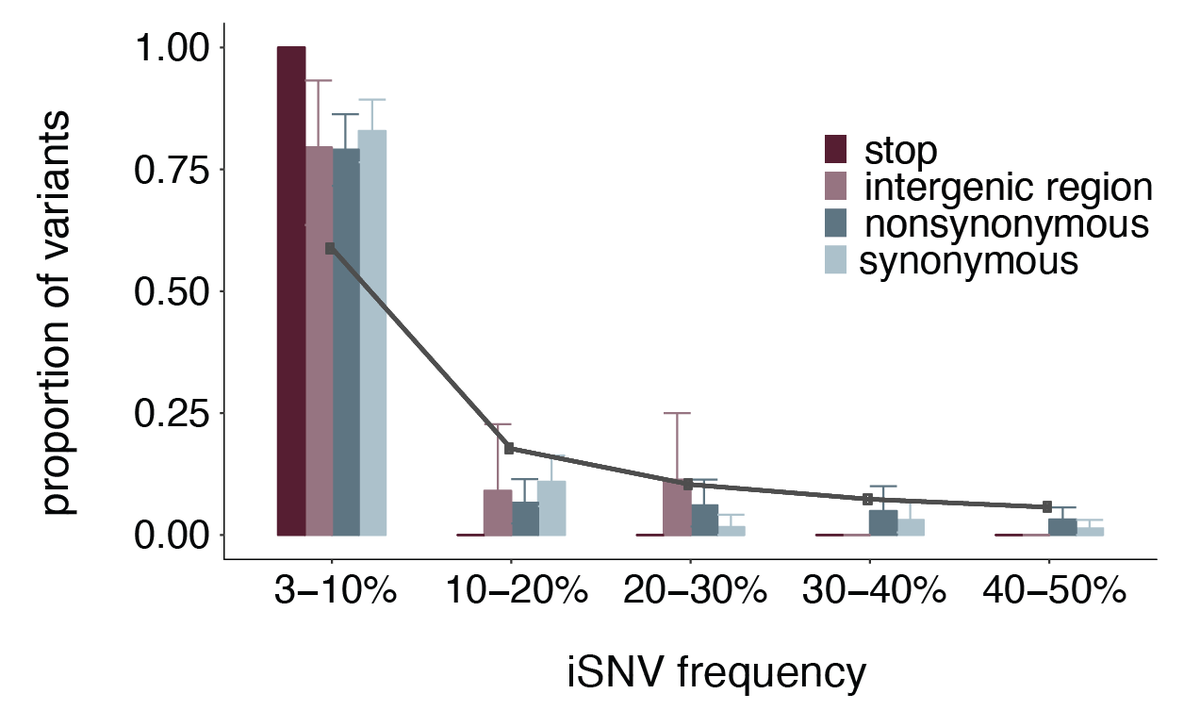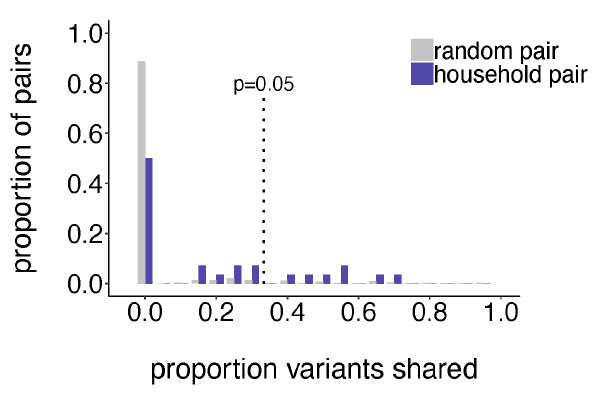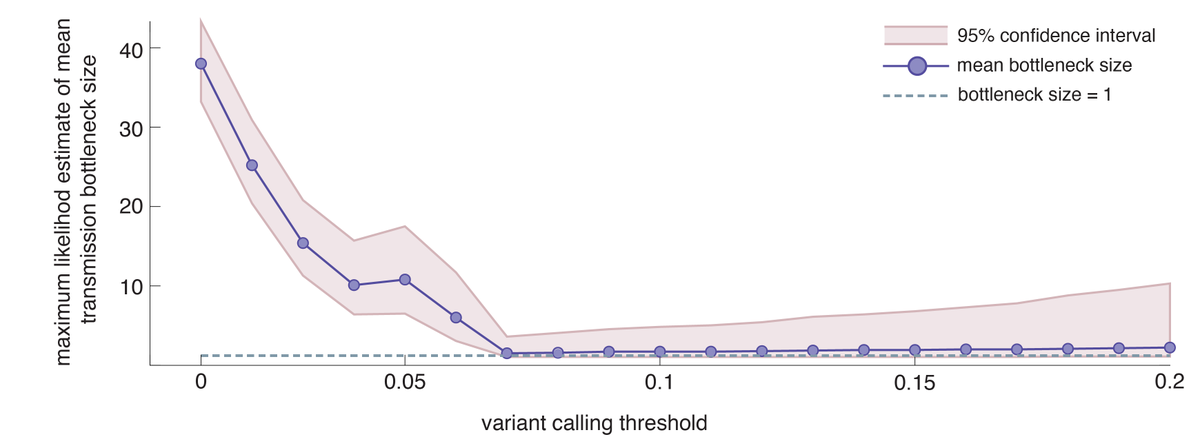New preprint  https://abs.twimg.com/emoji/v2/... draggable="false" alt="📢" title="Lautsprecheranlage" aria-label="Emoji: Lautsprecheranlage"> We deep seq’d #SARSCoV2 and found within-host diversity is limited and rarely transmitted & transmission bottlenecks are narrow → slows the pace of #VOC emergence in *acute* infxs. We need to
https://abs.twimg.com/emoji/v2/... draggable="false" alt="📢" title="Lautsprecheranlage" aria-label="Emoji: Lautsprecheranlage"> We deep seq’d #SARSCoV2 and found within-host diversity is limited and rarely transmitted & transmission bottlenecks are narrow → slows the pace of #VOC emergence in *acute* infxs. We need to  https://abs.twimg.com/emoji/v2/... draggable="false" alt="👀" title="Augen" aria-label="Emoji: Augen"> carefully at long-term infxs.
https://abs.twimg.com/emoji/v2/... draggable="false" alt="👀" title="Augen" aria-label="Emoji: Augen"> carefully at long-term infxs.  https://abs.twimg.com/emoji/v2/... draggable="false" alt="🧵" title="Thread" aria-label="Emoji: Thread"> 1/12
https://abs.twimg.com/emoji/v2/... draggable="false" alt="🧵" title="Thread" aria-label="Emoji: Thread"> 1/12  https://abs.twimg.com/emoji/v2/... draggable="false" alt="⬇️" title="Pfeil nach unten" aria-label="Emoji: Pfeil nach unten"> https://go.wisc.edu/dlm7zd ">https://go.wisc.edu/dlm7zd&qu...
https://abs.twimg.com/emoji/v2/... draggable="false" alt="⬇️" title="Pfeil nach unten" aria-label="Emoji: Pfeil nach unten"> https://go.wisc.edu/dlm7zd ">https://go.wisc.edu/dlm7zd&qu...
This was a highly collaborative project.  https://abs.twimg.com/emoji/v2/... draggable="false" alt="🙏" title="Gefaltete Hände" aria-label="Emoji: Gefaltete Hände"> Many thanks to @wcassias, @KatiaKoelle, @dho, @trvrb, and @tcfriedrich. Incredible leadership and mentorship from start to finish on this project from @LouiseHMoncla. And, of course, my partner in crime/science, @GageKMoreno. 2/12
https://abs.twimg.com/emoji/v2/... draggable="false" alt="🙏" title="Gefaltete Hände" aria-label="Emoji: Gefaltete Hände"> Many thanks to @wcassias, @KatiaKoelle, @dho, @trvrb, and @tcfriedrich. Incredible leadership and mentorship from start to finish on this project from @LouiseHMoncla. And, of course, my partner in crime/science, @GageKMoreno. 2/12
The emergence of #SARSCoV2 VOCs is concerning and raises https://abs.twimg.com/emoji/v2/... draggable="false" alt="❓" title="Rotes Fragezeichen-Symbol" aria-label="Emoji: Rotes Fragezeichen-Symbol">s about vaccine updates. Growing evidence says VOCs might arise during long-term infxs, but the vast majority of infxs are acute. So, we asked: can novel variants arise + transmit efficiently in acutely infected ppl? 3/12
https://abs.twimg.com/emoji/v2/... draggable="false" alt="❓" title="Rotes Fragezeichen-Symbol" aria-label="Emoji: Rotes Fragezeichen-Symbol">s about vaccine updates. Growing evidence says VOCs might arise during long-term infxs, but the vast majority of infxs are acute. So, we asked: can novel variants arise + transmit efficiently in acutely infected ppl? 3/12
To answer this https://abs.twimg.com/emoji/v2/... draggable="false" alt="❓" title="Rotes Fragezeichen-Symbol" aria-label="Emoji: Rotes Fragezeichen-Symbol">, we deep seq’d viruses from 133 #SARSCoV2 genomes and 28 putative household transmission pairs, and take advantage of our large consensus-level surveillance dataset (n=5,517) from the community where these individuals reside. 4/12
https://abs.twimg.com/emoji/v2/... draggable="false" alt="❓" title="Rotes Fragezeichen-Symbol" aria-label="Emoji: Rotes Fragezeichen-Symbol">, we deep seq’d viruses from 133 #SARSCoV2 genomes and 28 putative household transmission pairs, and take advantage of our large consensus-level surveillance dataset (n=5,517) from the community where these individuals reside. 4/12
Genetic diversity within hosts was very limited. Most of the infxs we looked at had ≤5 iSNVs, the majority of which were low frequency. Most iSNVs can only be found once and the variation that was shared was homopolymers and Wuhan-1 reversions. 5/12
Half of all putative household transmission pairs (14/28) share no iSNVs at all. A quarter of these pairs (7/28, purple) share more iSNVs than expected by chance (chance = random pairs, grey). Not enough shared variation to infer transmission w/o epi data. 6/11
We found a *single* instance of a within-host iSNV arising later at consensus levels. Even w/ a relatively dense dataset, we find NO evidence of iSNVs commonly giving rise to consensus SNPs along phylogenetically linked infxs. iSNVs in *acute* infxs ≠ consensus diversity. 7/12
Transmission bottlenecks in household pairs are *narrow* and sensitive to the variant calling threshold. Narrow bottlenecks → diversity is lost at the time of transmission → limited shared diversity in households and in phylogenetically linked infxs! 8/12
Results of #SARSCoV2 within-host studies have varied a bit. We think it’s in part bc #SARSCoV2 is particularly vulnerable to method error. Our study emphasizes the importance of duplicate sequencing for any studies relying on low-freq iSNVs to infer biological processes. 9/12
Overall, our data suggest acute infxs are unlikely to be common sources of novel variants. Future work is needed in long-term infxs / immunocompromised hosts where there is more time for mutations to arise, selection to act, and transmission to occur. 10/12
Check out these other great #SARSCoV2 within-host studies from @katrina_lythgoe and @alvalesano: 11/12
https://science.sciencemag.org/content/372/6539/eabg0821">https://science.sciencemag.org/content/3... https://journals.plos.org/plospathogens/article?id=10.1371/journal.ppat.1009499">https://journals.plos.org/plospatho...
https://science.sciencemag.org/content/372/6539/eabg0821">https://science.sciencemag.org/content/3... https://journals.plos.org/plospathogens/article?id=10.1371/journal.ppat.1009499">https://journals.plos.org/plospatho...
Check out these #SARSCoV2 studies looking at evolution in chronic infxs: 12/12
https://www.nejm.org/doi/full/10.1056/NEJMc2031364
https://www.nejm.org/doi/full/... href=" https://academic.oup.com/jid/article/223/1/23/5934826">https://academic.oup.com/jid/artic... https://www.nature.com/articles/s41586-021-03291-y">https://www.nature.com/articles/...
https://www.nejm.org/doi/full/10.1056/NEJMc2031364
BONUS. One of our favorite parts of working on a new manuscript is getting to choose a new color scheme. This paper’s color scheme was inspired by the amazing women of the 2021 inauguration.  https://abs.twimg.com/emoji/v2/... draggable="false" alt="💃" title="Tanzende Frau" aria-label="Emoji: Tanzende Frau"> https://github.com/ciannabp/inauguration">https://github.com/ciannabp/...
https://abs.twimg.com/emoji/v2/... draggable="false" alt="💃" title="Tanzende Frau" aria-label="Emoji: Tanzende Frau"> https://github.com/ciannabp/inauguration">https://github.com/ciannabp/...

 Read on Twitter
Read on Twitter





